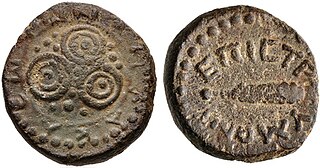Related Research Articles
Postumius Rufius Festus Avienius was a Latin writer of the 4th century AD. He was a native of Volsinii in Etruria, from the distinguished family of the Rufii Festi.

The Derveni papyrus is an ancient Greek papyrus roll that was found in 1962. It is a philosophical treatise that is an allegorical commentary on an Orphic poem, a theogony concerning the birth of the gods, produced in the circle of the philosopher Anaxagoras. The roll dates to around 340 BC, during the reign of Philip II of Macedon, making it Europe's oldest surviving manuscript. The poem itself was composed near the end of the 5th century BC, and "in the fields of Greek religion, the sophistic movement, early philosophy, and the origins of literary criticism it is unquestionably the most important textual discovery of the 20th century." While interim editions and translations were published over the subsequent years, the manuscript as a whole was finally published in 2006.
In ancient Greece the chief magistrate in various Greek city states was called eponymous archon. "Archon" means "ruler" or "lord", frequently used as the title of a specific public office, while "eponymous" means that he gave his name to the year in which he held office, much like the Roman dating by consular years.

Heraclea Sintica, also known as Heraclea Strymonike, was an ancient Greek city located near what is now the village of Rupite in south-western Bulgaria.
Adrian Swayne Hollis was an English classical scholar and correspondence chess grandmaster, the title having been awarded in 1976.

Alfred Twardecki is a Polish historian of antiquity and translator. He works as curator at the Department of Ancient and Eastern Christian Art in the National Museum in Warsaw. He graduated in 1986 from the Department of History of Warsaw University.

Totenpass is a German term sometimes used for inscribed tablets or metal leaves found in burials primarily of those presumed to be initiates into Orphic, Dionysiac, and some ancient Egyptian and Semitic religions. The term may be understood in English as a "passport for the dead". The so-called Orphic gold tablets are perhaps the best-known example.
The gens Lartia, also spelled Larcia, or rarely Largia, was a patrician family at ancient Rome, whose members earned great distinction at the beginning of the Republic. Spurius Larcius was one of the two companions of Horatius, who defended the Pons Sublicius against Lars Porsena in 508 BC. A few years later, Titus Larcius became the first Roman dictator. However, the gens all but vanishes from history after this period. A family of the same name existed in the late Republic and under the early Empire, but their relationship to the earlier Lartii is unknown.
Peter Kruschwitz FHEA FRHistS M.A.E. is Professor of Ancient Cultural History at the University of Vienna. He specialises in Roman poetic culture and song culture with a particular focus on Latin verse inscriptions and non-elite cultural practice. He has published widely on Roman comedy, Latin linguistics and Roman linguistic discourse, the wall inscriptions of Pompeii and Herculaneum, and Roman metre.
Peter Allan Hansen was a Danish classical philologist known principally for his work on the Carmina epigraphica graeca I-II and on other aspects of Greek epigraphy. Born in Copenhagen he was educated at Copenhagen University and at Brasenose College, Oxford, where he was a pupil of Lilian H. Jeffery. After 1975 he settled in Oxford and through the support of scholarships and grants continued his work on Hesychios and epigraphy there.
Paullus Aemilius Regillus or Regulus was a Roman Senator and grandnephew of the emperor Augustus.
Stephen Victor Tracy is an American scholar of Classics specializing in ancient Greek Epigraphy. Inscriptions are one of the most important classes of primary evidence that comes down to us from antiquity. Tracy is best known for devising a method for recognizing the work of individual inscribers. It was long thought that the intractability of the medium made this impossible. But by treating the inscribed letters as a kind of handwriting he has been able to establish careers for many cutters, to join discrete fragments, to date inscriptions more accurately than in the past, and often thereby make it possible to reach a new understanding of historical events.

The theta nigrum or theta infelix is a symbol of death in Greek and Latin epigraphy. Isidore of Seville notes the letter was appended after the name of a deceased soldier and finds of papyri containing military records have confirmed this use. Additionally it can be seen in the Gladiator Mosaic.
Marcus Paccius Silvanus Quintus Coredius Gallus Gargilius Antiquus was a Roman senator of the 2nd century. He was suffect consul in the nundinium of May to June 119 as the colleague of Quintus Vibius Gallus. Gargilius Antiquus is primarily known through inscriptions.
Gaius Quinctius Certus Poblicius Marcellus was a Roman senator active in the first quarter of the second century AD. He was suffect consul for the nundinium of May to June AD 120, with Titus Rutilius Propinquus as his colleague. The more common and shorter version of his name is Gaius Poblicius Marcellus; he is known primarily from inscriptions. He later served in Syria as the imperial legate.
Sheila Louise Ager is a Canadian Lecturer and the Director of Hellenistic Studies at the University of Waterloo, Ontario. Her principal area of interest is Greek history, focusing on the Hellenistic Age, from 323 BC to 30 BC. She has further interest in interstate relations in the Hellenistic Period, and much of her work centres on the concept of peaceful resolution of disputes. She also researches the Ptolemaic dynasty, especially its final ruler, Cleopatra VII.
John Edward Houghton Spaul (1926–2018), sometimes known professionally as J. E. H. Spaul, was a British ancient historian and epigrapher. Much of his work focused on the Army of the Roman Empire.